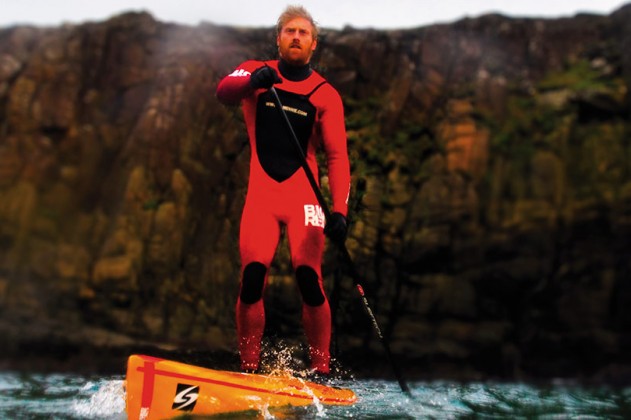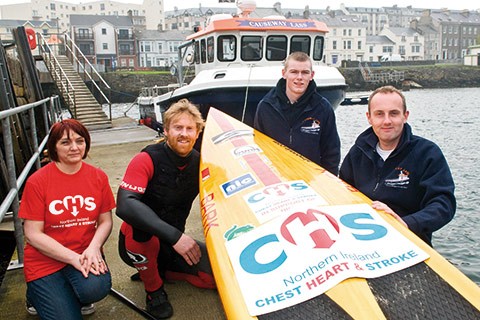I have a habit of doing things that at a later date I look back upon and my first thought is “Where did I go in my head to pull that off?”
With: Al Mennie
(This feature originally appeared in the Spring 2012 issue of SUP International. Print and digital subscriptions for readers worldwide are available HERE.)
I was walking along the beach at The Whiterocks, Portrush, today and in the distance I could see the Scottish island of Islay. It’s not uncommon to see Islay from Northern Ireland as long as the weather allows it but today I studied it in much more detail than before. Seven days ago I was half way across the North Channel among commercial trawlers, tankers, an oil rig and a war ship as I paddled from The Giants Causeway, Northern Ireland to Islay. To any seasoned distance paddler, the distance of 25 miles as the crow flies would not be very significant at all but it was never the distance that concerned me in the planning stages. This stretch of water is notorious for strong tides and currents as the Irish Sea and The Sea of Jura meet with The Atlantic Ocean. The tide flows out in a NW direction and then back in a SE direction with counter flows at opposite sides of the channel. I planned to paddle in a northerly direction and allow the flow to carry me out west and then push me back across. I could have left from a location further east or west and got more of a benefit from the pull of the tide but I figured that would be too easy and anyone could do that, so I chose to make it more difficult by leaving from The Causeway. This would have meant fighting the tide from about 4hours into the crossing. It was crucial that I chose a neap tide to cross on so I at least had a chance to be able to fight against the incoming tide and not be pushed back.
I pretty much made it as difficult for myself as possible within reason and so I had to prepare for it both mentally and physically. I chose to cross in March to add another challenging factor to the crossing in that it would most likely be freezing cold. My friend and trainer Richard Robinson adapted my big wave training plan to a two month regime of 40minute sprints, long distances, circuits and weights. This was difficult to keep up in winter with howling west winds and freezing temperatures but I didn’t miss a day despite being so cold at times that my legs felt numb from the knees down! I knew there was a strong likelihood that the currents and chop in the channel could throw me off my board a lot to the point that standing may be counterproductive so I trained equally in standing up and also in prone position to deal with that possibility. The only problem was that if I had to resort to prone I knew that I would be going about half as fast as standing.
So I had lots of challenges to deal with so I made sure I was as ready as I could be to handle whatever came my way on the day. It was very similar to the preparation before a big swell. There were only so many eventualities I could prepare for but the unknown factors were something I had to hedge against in case conditions changed. This crossing has never been attempted before on a paddleboard so I only had the knowledge of the old fishermen to go on and a bit of input from the odd sea kayaker which funnily enough all seemed to contradict one another. There was a distinct vibe, from certain people, that I wouldn’t be able to make it because of the tides but I love that extra fuel for the mind and I knew I would have that to draw upon if all else failed.
I had people trying to tell me to add wind pennants, centre skegs, ballast, a small sail and a few other strange ideas. If I said I was going to paddle a door over to Scotland then that’s what I would have used. Lots of people didn’t seem to get that. I have a reputation among my friends of being extremely stubborn when I take something on. There have been times I will refuse to put tow boards in my van before heading off to surf a huge swell so that I make myself paddle. I’ll happily tow others in but I will make myself paddle or I won’t surf. So when I chose to do this mission I knew that even if the tide proved too strong for me to fight I would have sat out there on my board refusing to get on the support boats until the tide turned.
When I got to the rocks at The Causeway at 6am in the dark and was ready to paddle out, I lay on the ground and shut my eyes and told myself “As soon as you leave these rocks you are not stopping until you get to Scotland” I started off well with a light south wind behind me and got 12 miles under my belt in just less than three hours or so and then the wind switched easterly, the tide turned into the wind and the surface got really uneven. I struggled to make good ground standing as I kept getting tipped off in the surface chop. I kept trying for about 20 minutes as I knew I move much faster standing than in prone but I ended up ditching the paddle and getting on with it lying down. I was told by the skippers of the support boats Richard and Howard that I’d have to fight for about an hour to get across a large rise in the sea bed and then I should be back to a decent speed. This wasn’t the case and as the tide began to build flow my speed deteriorated to 1.6mph at one stage and that was with constant paddling only stopping for 30 seconds every 15 minutes to refuel.
Hours 4, 5, 6 and 7 became a blur of constant paddling and only moving very slowly forward. Psychologically this was destroying me. I was going well and then I was almost at a standstill. I needed constant reassurance every 10 minutes from Howard that I was still making progress and he would sketch maps to show me how I’d been moving. After paddling for 10 minutes flat out, hearing that you’ve only moved 0.2 of a mile was pretty demoralising but at least I was moving! I didn’t once feel sore or like giving up but moving very little was tough on my mind. In training I had reached 23 miles in just over 5 hours along the coast of Northern Ireland. This crossing ended up at around 30 miles and taking almost twice as long at 9hrs 25 minutes.
It goes to show that physical training is really important for confidence, stamina and endurance against the elements but equally important against the elements was my knowledge of the ocean, input from others, my own ability and my mental preparation and determination which basically boils down to complete stubbornness. After the crossing, skipper Richard Connor who navigated my route said to me, “You’re the thickest man I have ever met!” I wasn’t quite sure how to take that at the start but it turns out to be a colloquialism for determined or stubborn which in this case I would have to agree with.
I did the challenge to raise money for Northern Ireland Chest heart and Stroke Association and I am very grateful to all the people who donated over £2500, and all my sponsors who helped me achieve it (full list on my website). I was inspired to do it by the efforts of Iron Man Nick Thorn and Cross Atlantic rower Kate Richardson who have both achieved amazing feats for charity and make my crossing look like a drop in the ocean compared to theirs. Follow Al at www.almennie.com SUP
“ I chose to cross in March to add another challenging factor in that it would most likely be freezing cold ”


